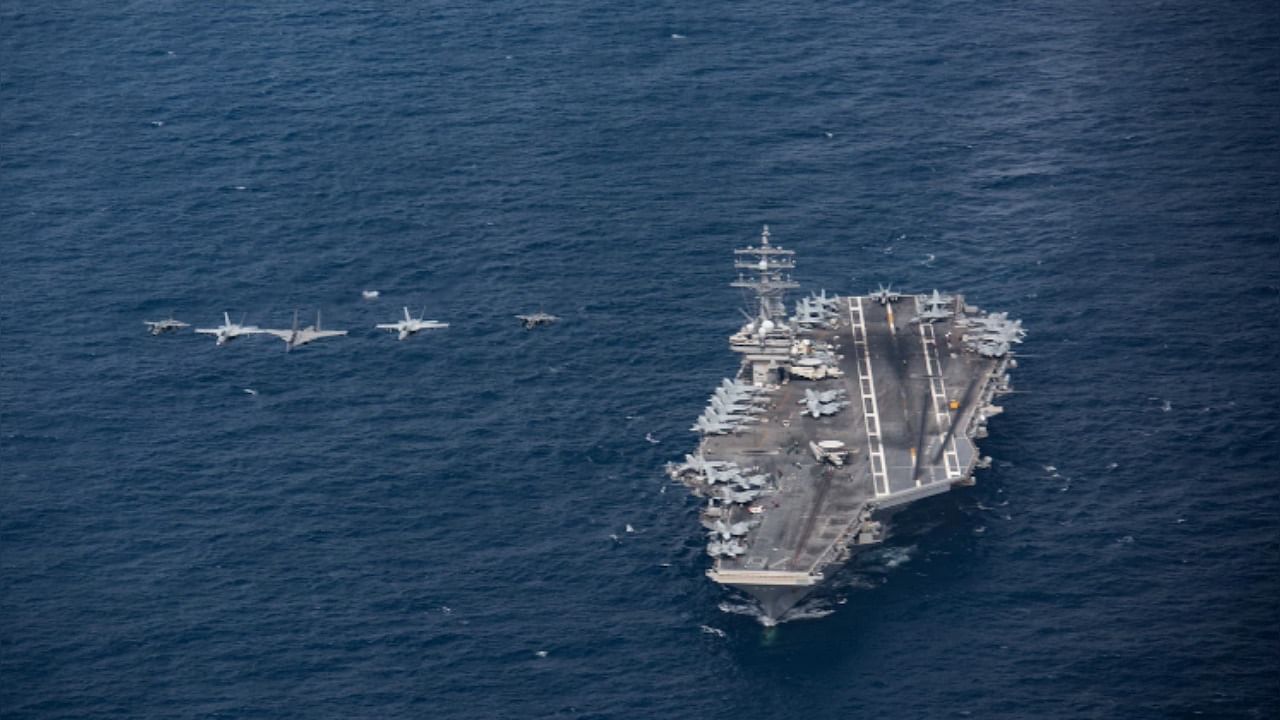
India’s warships and fighter aircraft had a joint drill with the United States Navy’s Ronald Reagan Carrier Strike Group, which recently conducted “maritime security operations” in the South China Sea, riling up China.
The multi-domain drill on Wednesday and Thursday was intended to send out a message to China, which of late not only restarted deploying a large number of troops closer to its disputed boundary with India but also conducted a high-altitude military drill in Tibet, simulating battle situations that required integrated operations by different units of its People’s Liberation Army.
The drill sharpened the regional maritime security construct to uphold a rules-based maritime order in the Indian Ocean region, the US Navy stated.
“Our nations share a common interest in a secure Indo-Pacific,” said Rear Admiral Will Pennington, commander of the American Navy’s Ronald Reagan Carrier Strike Group – a.k.a Carrier Strike Group 5 (CSG 5) or Task Force 70 – after the joint drill with the warships of the Indian Navy and the fighter aircraft of the Indian Air Force. “Working collectively with like-minded nations to provide full-spectrum awareness and defence of the vast Indian Ocean expanse ensures stability in the region.”
The US Navy’s CSG 5 included its only forward-deployed aircraft carrier USS Ronald Reagan, Destroyer Squadron 15, Ticonderoga-class guided-missile cruiser USS Shiloh and Arleigh Burke-class guided-missile destroyer USS Halsey as well as the aircraft from the Carrier Air Wing 5.
The Indian Navy warships, which participated in the drill, included a Kolkata-class guided-missile destroyer INS Kochi, a Talwar-class frigate INS Teg, a P-8I maritime patrol and reconnaissance aircraft, MiG-29K fighters from the Indian Navy Air Squadron 303. Besides, the Su-30 fighter aircraft from the Indian Air Force 222 Squadron also took part in the exercise with the US Navy ships.
The drill included an anti-submarine exercise, aerial exercises, like dissimilar aircraft combat training, detect-to-engage sequence, helicopter cross-decking and formation maneuvering.
The series of at-sea exercises reinforced the converging maritime interests of the US and India, comes on the heels of External Affairs Minister S Jaishankar’s meeting with the US Secretary of Defence, Lloyd Austin, in Washington DC last month. Austin had also visited New Delhi in March and had a meeting with his counterpart Defence Minister Rajnath Singh.
The Indian Navy vessels have been holding joint drills with the US Navy’s warships returning from deployment in the South China Sea – more regularly since the Chinese PLA’s aggressive move to unilaterally change the status quo along the China-India Line of Actual Control (LAC) in eastern Ladakh and counter-deployment by the Indian Army in April and May 2020 resulted in a stand-off.
The Indian Navy ships had joint drills with the Nimitz Carrier Strike Group of the US Navy in the Indian Ocean in July 2020. The Indian Air Force’s aircraft joined the Indian Navy ships for another joint drill with the US Navy’s Theodore Roosevelt Carrier Strike Group on March 27 and 28 this year. Both the Nimitz Carrier Strike Group and the Theodore Roosevelt Carrier Strike Group were returning from deployment in the South China Sea when they conducted drills with the Indian Navy ships.
“Flying with our counterparts from the Indian Navy and Air Force has been a great opportunity for the aircrew assigned to CTF (Carrier Task Force) 70, providing challenging airborne scenarios necessary for building the confidence to operate effectively together within the Indo-Pacific region,” Cmdr. Daniel O'Hara, commanding officer, Strike Fighter Squadron (VFA) 102 was quoted in a US Navy statement. “We developed critical relationships that we hope to renew in the near future with a shared and continued focus on multinational interoperability and the highest levels of professional airmanship.”
Though almost 14 months passed since the stand-off between India and China along the LAC in eastern Ladakh started, the series of talks between the diplomats and senior military commanders of the two sides could not yet resolve it completely. The stand-off took the relationship between New Delhi and Beijing to a new low but brought India’s strategic convergence with the US in the Indo-Pacific under renewed focus.
